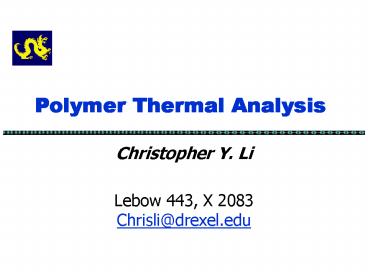Polymer Thermal Analysis - PowerPoint PPT Presentation
1 / 24
Title:
Polymer Thermal Analysis
Description:
Disordered State Crystallization Crystalline State. Gibbs free energy change: ... DSC heating curve of PEEK, Poly(oxy-1,4 phynyleneoxy ... – PowerPoint PPT presentation
Number of Views:1649
Avg rating:3.0/5.0
Title: Polymer Thermal Analysis
1
Polymer Thermal Analysis
- Christopher Y. Li
- Lebow 443, X 2083 Chrisli_at_drexel.edu
2
Suggesting Reading
- Thermal Analysis, by Bernhard Wunderlich Academic
Press 1990. - Calorimetry and Thermal Analysis of Polymers, by
V. B. F. Mathot, Hanser 1993
3
The Advanced THermal Analysis System ATHAS
http//web.utk.edu/athas/
4
Class Outline
- Concept of thermal analysis
- Differential Thermal Analysis (DTA) and
Differential Scanning Calorimetry (DSC) - Crystallization and Melting
- Glass Transition
- Questions
5
Concept of thermal analysis
Temperature Scale Newton 1701, freezing point
of water 0, body, 12 Fahrenheit 1714, freezing
point of water mixed with salt 0 , body 96
freezing point of water 32, boiling point of
water 212 Celsuis 1742, freezing point of water
0, boiling point of water 100
6
Concept of thermal analysis
Heat The macroscopically observed heat has its
microscopic origin in molecular motion. Unit J
(m2kgs-2, 1 cal 4.184 J) dQ dU pdV Q
heat, U internal energy, p pressure, V volume H
U pV H, enthalpy Cp dQ/dT (?H/?T)p,n Heat
capacity
7
Techniques of Thermal Analysis
- Thermometry temperature
- Calorimetry heat
- Differential Thermal Analysis
- Thermomechanical analysis(TMA) length and
stress) - Dilatometry volume and pressure
- Dynamic Mechanical Analysis (DMA)
- Thermogravimetry (mass)
8
Leading Companies
- Perkin Elmer Thermal Analysis Systems
- http//www.perkin-elmer.com/thermal/index.html
- TA Instruments Home Page
- http//www.tainst.com/
- METTLER TOLEDO Thermal Analysis Systems
- http//www.mt.com/
- Rheometric Scientific Home Page
http//www.rheosci.com/ - Haake http//polysort.com/haake/
- NETZSCH Instruments http//www.netzsch.com/ta/
- SETARAM Instruments http//setaram.com/
- Instrument Specialists Inc. http//www.instrument
-specialists.com/
9
Differential Thermal Analysis (DTA)
DTA measures temperature difference
10
Differential Scanning Calorimetry (DSC)
Exothermal dQ/dT
Temperature
The DTA method applied to the measurement of heat
is called DSC.
11
Differential Scanning Calorimetry
Temperature Range 110 K- 1000K Heating rate 0.1
500k/min (normally 0.5-50 K/min) Noise is ?
4?w Sample volume up to 75 mm3
Perkin-Elmer DSC 7
12
Polymers are large molecules
Molecular weight Na 23, CO2 44. PE
Polyethylene ----(CH2)n--- molecular weight
could be as high as millions!
13
The conformation of a polyethylene macromolecule
Typical molecule
500 cm
C20000H40002, MW 280,000 Contour Length 3,100
nm Planar zig-zag conformation
(Magnification 2,000,000)
Atomic model of a planar zig-zag conformation
(Magnification 108 ?)
14
Random conformationof a macromolecular chain
Random coil conformation
A number of different conformations
320,000 1010,000
RMS end-to-end distance ? 10 cm (108?)
15
Molecular Distribution
Molecular Distribution Mn ? NXMX/ ? NX, MW
? NXMX2/ ? NXMX MW/Mn 1 10 or even
more Molecular weight distribution is a unique
characteristic of polymers. Broad molecular
weight distribution could broaden the crystal
melting Peak.
16
Classification of Polymers
Amorphous polymer Atactic polystyrene, poly
methyl methacrylate Crystalline polymers
polyethylene, polyethylene terphthalate Plastic
s, rubber, thermal-plastic elastmers, resin The
softness depends on the glass transition
temperature for amorphous polymers. Crystallizati
on could also harden polymer
17
Crystallization and Melting
Disordered State ? Crystallization ?
Crystalline State
Gibbs free energy change ?G Gcrystal -
Gmelt ?G ?H - T?S At Tm ?G ?H - Tm?S
0 Tm ?H/?S
Typical melt-grown polyethylene spherulites
18
The three macromolecular conformations in
condensed states
Extended chain presents equilibrium crystals.
1. Produced by annealing e.g. polyethylene
polytetrafluoroethylene polychlorotrifluoroethy
lene 2. Produced by crystallization during
polymerization e.g. polyoxymethylene
polyphosphates, selenium
Lamellar crysteals and Clusters Crystallinity
concept the molecules are much larger than the
crystals
Chain folded 1. Fold length 5 -50 nm 2. Best
grown from dilute solution 3. Metastable lamellae
because of the large fold surface area
Glassy amorphous 1. Random copolymers 2. Atatic
stereoisomers e.g. PS, PMMA, PP
3.Quenched slow crystallizing
molecules e.g. PET, PC and others.
19
Crystallization and melting
Exothermal
DSC heating curve of PEEK, Poly(oxy-1,4
phynyleneoxy- 1,4-phenylenecarbonyl-1,4-phenylene)
, heating rate 10 K/min
20
Polymer Phase Transitions
First order transition (??G/?T) -?S ? 0,
(?2?G/?T2) ? 0 Crystallization and
melting Second order transition (??G/?T) -?S
0, (?2?G/?T2) ? 0 Glass transition is a
quasi second order transition.
21
Glass Transition
In certain crystallizable materials, fast cooling
can take the material Pass the freezing point and
the liquid apparently solidifies
without Crystallizing and without a discontinuity
in quantities such as the volume. There is a
change in the slope of the volume/temperature
curve.
liquid
Glass transition
Volume
glass
crystal
Temperature
Paul C. Painter and Michael L. Coleman,
Fundamentals of polymer science, Technomic
Lancaster PA, 1994
22
How to observe Tg
Exothermal
Exothermal
Temperature
Experimental curves on heating after cooling at
0.0084 K/min (1), 0.2 K/min (2) 0.52 K/min (3),
1.1 K/min (4), 2.5 K/min (5), 5 K/min (6), and 30
K/min.
23
TGA of a series of Polymers
24
Questions
- Concept DTA, DSC,TGA
- What is the normal scanning rate of DSC for
polymer measurement? - What does a typical curve of polymer
crystallization look like? - What does a typical curve of polymer melting look
like? - What are the typical features about POLYMER
crystallization and melting curves? - What is glass transition? What does a typical
curve of polymer melting look like? Why it is
different from crystallization, or melting curve?































